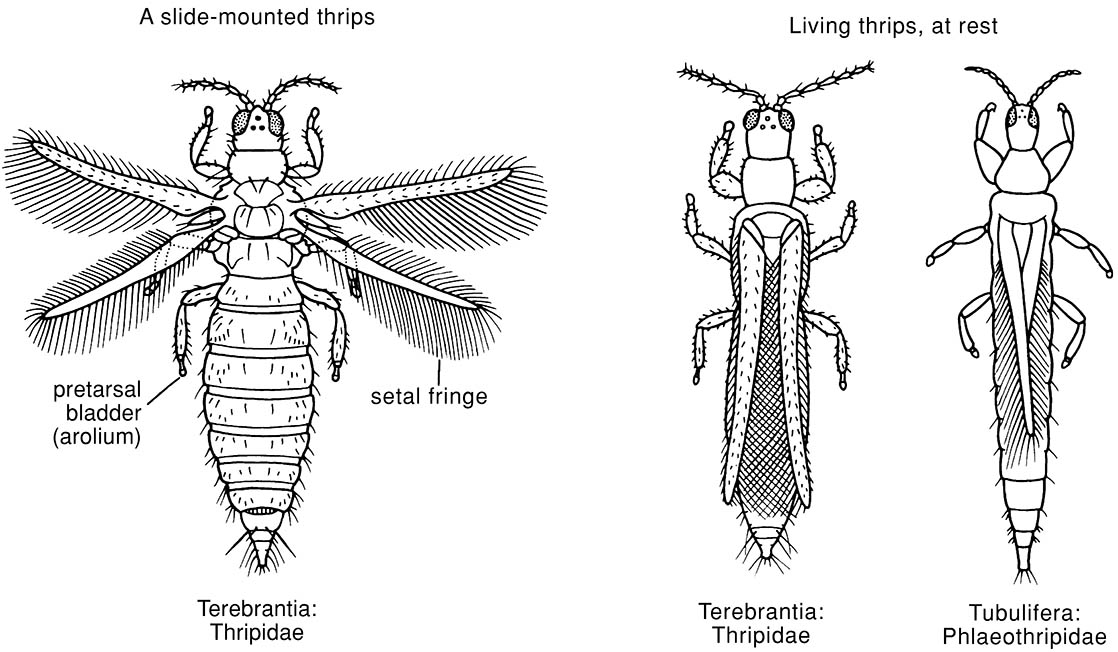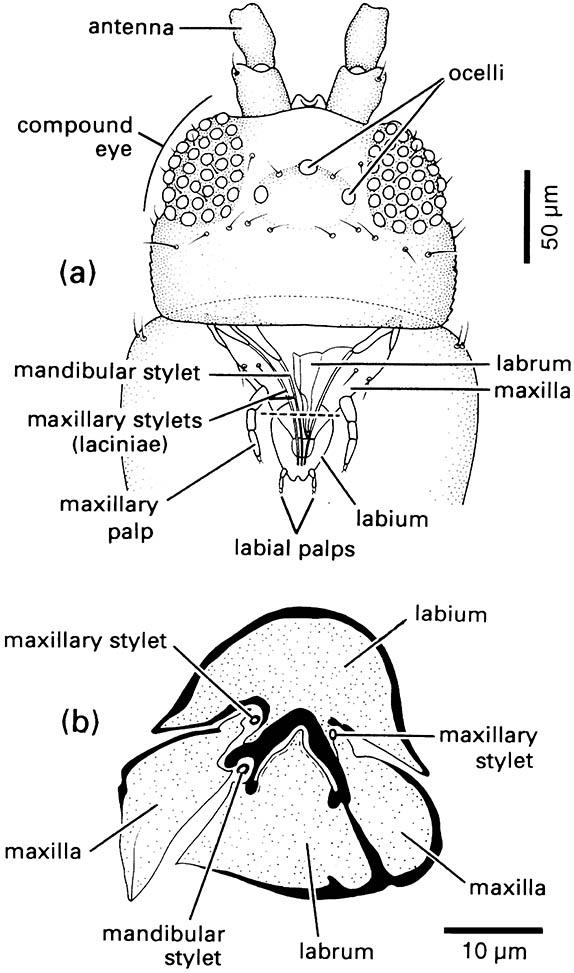Box 11.7. Thysanoptera (thrips)
The Thysanoptera is a worldwide order of minute to small insects (from 0.5 mm to a maximum length of 15 mm), comprising about 5000 species in two suborders: Terebrantia with seven families (including the speciose Thripidae); and Tubulifera with one family (the speciose Phlaeothripidae). Their development is intermediate between hemi- and holometabolous. The body is slender and elongate, and the head is elongate and usually hypognathous. The mouthparts (Fig. 2.13a) comprise the maxillary laciniae formed as grooved stylets, with the right mandible atrophied and the left mandible formed as a further stylet; the maxillary stylets form a feeding tube. The compound eyes range from small to large, and there are three ocelli in fully winged forms. The antennae are four- to nine-segmented and anteriorly directed. Thoracic development varies according to the presence of wings; fore and hind wings are similar and narrow with a long setal fringe (as illustrated on the left for a terebrantian thrips, after Lewis 1973). At rest the wings are parallel in Terebrantia (middle figure) but overlap in Tubulifera (right figure); microptery and aptery occur. The legs are short and gressorial, some- times with the fore legs raptorial and the hind legs saltatory; the tarsi are one- or two-segmented, and the pretarsus has an apical protrusible adhesive arolium (bladder or vesicle). The abdomen is 11-segmented (though with only 10 segments visible). In males the genitalia are concealed and symmetrical. In females the cerci are absent; the ovipositor is serrate in Terebrantia, very reduced in Tubulifera.
Eggs are laid into plant tissue (Terebrantia) or into crevices or exposed vegetation (Tubulifera). The first- and second-instar nymphs resemble small adults except with regard to their wings and genitalia; however, instars 3–4 (Terebrantia) or 3–5 (Tubulifera) are resting or pupal stages, during which significant tissue reconstruction takes place. Female thrips are diploid, whereas males (if present) are haploid, produced from unfertilized eggs. Arrhenotokous parthenogenesis is common; thelytoky is rare (section 5.10.1).
The primitive feeding mode of thrips probably was fungal feeding, and about half of the species feed only on fungi, mostly hyphae. Most other thrips primarily are phytophages, feeding on flowers or leaves and including some gall inducers, and there are a few predators. Plant-feeding thrips use their single mandibular stylet to pierce a hole through which the maxillary stylets are inserted. The contents of single cells are sucked out one at a time; pollen- or spore-feeding thrips similarly remove the contents of individual pollen grains or spores. Several cosmopolitan thrips species (e.g. western flower thrips, Frankliniella occidentalis) act as vectors of viruses that damage plants. Thrips may aggregate in flowers, where they may act as pollinators. Subsocial behavior, including parental care, is exhibited by a few thrips (section 12.1.1).
Phylogenetic relationships are considered in section 7.4.2 and depicted in Fig. 7.2.


(a) Dorsal view of head showing mouthparts through prothorax. (b) Transverse section through proboscis. The plane of the transverse section is indicated by the dashed line in (a). (After Matsuda 1965; CSIRO 1970)

Broken lines indicate uncertain relationships. Thysanura sensu lato refers to Thysanura in the broad sense. (Data from several sources)



